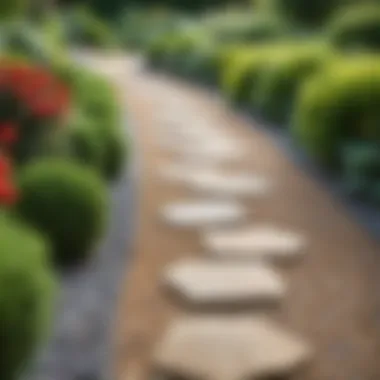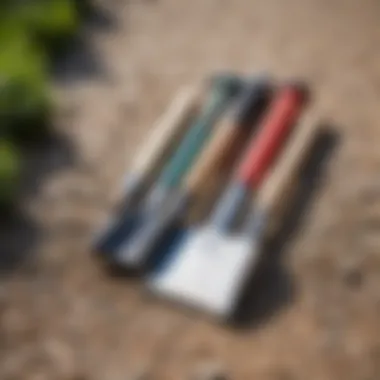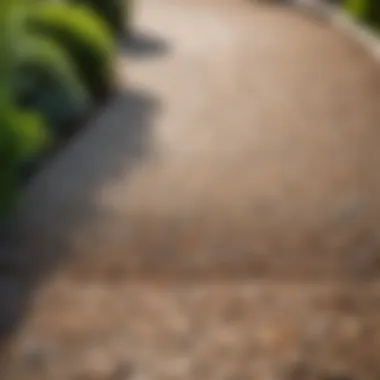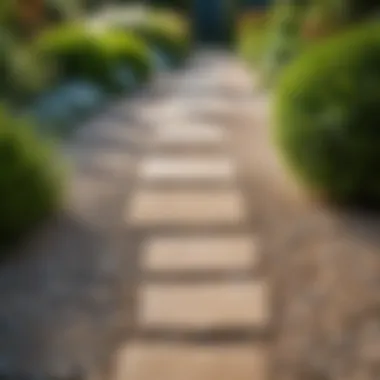Build Your Dream Gravel Pathway: Step-by-Step Guide


Intro
Creating a gravel pathway in your garden can significantly enhance its overall aesthetic while also providing a practical route for foot traffic. This guide lays a framework for homeowners and DIY enthusiasts to embark on the project with adequate preparation and foresight.
To build a durable and visually appealing gravel path, you need to delve into the realms of design, material choices, and construction techniques. Clarity on these aspects is important for ensuring that the pathway serves both functional and stylistic purposes.
The subsequent sections will guide you through each phase of this process. From initial planning to material selection, every detail will help you navigate your way to success in this endeavor.
Проектирование и планирование
Design and planning are essential first steps when creating a gravel pathway. A well-thought-out plan can save time and resources later on, preventing costly mistakes.
Как выбрать проект для DIY
Selecting the right design is crucial. Consider your garden’s layout and the intended use of the path. Would you prefer a straight path for efficiency or a curved one for visual appeal? You can find various inspirations by visiting platforms like Reddit or Pinterest, where other DIY enthusiasts share their projects. Keep in mind that the scale of the pathway must be proportional to the surrounding landscape.
Оценка времени и ресурсов
Time management and resource allocation also play vital roles in successful project execution. Estimate how long each phase will take, from preparation to final installation. Identify tools and materials required. Common materials include gravel, landscape fabric, and edging, along with tools such as a shovel, rake, and a wheelbarrow. Prepare a checklist so that you can methodically verify that everything is in order before getting started.
Выбор материалов
Selecting appropriate materials is one of the most critical factors affecting the longevity and visual appeal of your gravel path. The variety of gravel types can suit different styles and functions.
Типы материалов для различных проектов
Gravel types vary widely. For example, pea gravel is smooth and rounded, making it comfortable for walking, while crushed stone offers better support and firmness underfoot. The choice also comes down to aesthetics; colors and sizes differ, providing numerous options to complement your garden.
Советы по покупке и экономии
When purchasing materials, consider buying in bulk, as it can reduce costs significantly. Local suppliers often provide the best rates. Don't hesitate to ask for recommendations or check reviews before making your purchase. Always verify measurements and quantities to avoid shortages or excessive waste.
"The right materials will not only enhance the appearance of your path but also ensure its functionality for years to come."
With the planning and material selection behind you, the time is ripe to move on to the actual construction. Each step builds upon the last, leading to a cohesive and rewarding project.
Foreword to Gravel Pathways
Creating a gravel pathway in your garden serves not only aesthetic preferences but also practical purposes. Pathways are essential to guide visitors and enhance accessibility, making them a fundamental aspect of garden design. They can delineate different areas, promoting organization in the landscape. Moreover, gravel paths contribute to drainage and reduce erosion, which are crucial considerations for any sustainable garden design.
Defining Gravel Pathways
Gravel pathways are defined as walkways made primarily from loose stones. This form of surfacing is laid over a prepared base, designed to allow for easy walking while providing stability. The gravel can vary in size, color, and composition, including types such as crushed stone and pea gravel. Such pathways are often preferred for their natural look and ability to blend seamlessly into various garden styles.
Benefits of Gravel Pathways
Gravel pathways come with numerous benefits:
- Cost-effective: Compared to other surfacing materials, gravel is usually more affordable and requires less maintenance over time.
- Easy Installation: With basic tools and materials, homeowners can create these paths with relative ease.
- Natural Aesthetics: The use of gravel allows for an organic feel in the garden, which can enhance the outdoor experience.
- Good Drainage: Gravel allows water to permeate, helping prevent puddles and flooding in your garden.
Gravel pathways serve both functionality and beauty, harmonizing your outdoor space.
Planning Your Gravel Pathway
Planning is a crucial stage in creating a gravel pathway in your garden. A well-structured plan not only maximizes the aesthetic appeal of the garden but also ensures the pathway is functional and durable. Proper planning factors in the layout, the type of materials to use, and the amount of time needed for installation. Skipping this step can result in poor design choices that might lead to future maintenance issues or aesthetic displeasure.
Assessing the Area
Before beginning the installation, it is important to thoroughly assess the area where the pathway will be laid. Look for the size and shape of the space available. Ensure that there are no existing obstacles such as trees or flush surfaces that might disrupt the pathway. You should also consider the drainage pattern of your garden. Water runoff areas can erode the gravel over time if not properly managed. A clear understanding of the area helps in mapping out the layout you would like to achieve, avoiding any unforeseen complications later in the process.


Choosing the Right Design
The design of your gravel pathway greatly influences its functionality and appearance. Here are some design options you can consider:
Straight paths
Straight paths are typically the easiest to construct and offer a clean, direct route from one point to another. Their simplicity is a key characteristic and makes them a popular choice for many garden styles. A straight pathway can enhance the overall geometric design of a garden, making it feel more organized. On the downside, straight paths may seem less inviting than more whimsical designs. However, they are excellent for creating clear navigation in larger gardens.
Curved paths
Curved paths add a sense of movement and intrigue to gardens. This type of pathway can guide visitors through various parts of your garden, encouraging exploration. The transition from one section to another becomes softer and more organic. Curved paths require more planning and may involve more materials, which can add to the overall cost. Still, their beauty often outweighs these considerations.
Multi-functional paths
Multi-functional paths serve more than just a transit purpose; they can also act as a space for seating or additional plantings. This characteristic of dual utility expands the functionality of your garden significantly. They can be more complex to design, as they need to accommodate both foot traffic and any other uses. However, their versatility can open up lots of creative opportunities in your outdoor space—a feature that is notably appealing.
Selecting Gravel Type
The type of gravel you choose will greatly impact both the functionality and the visual appeal of your pathway. Here are some options to consider:
Crushed stone
Crushed stone is popular for its varied colors and textures, which can add visual interest. It has good drainage properties and compacts well, providing a sturdy surface for foot traffic. However, over time, crushed stone may need replenishing to maintain its appearance and stability.
Pea gravel
Pea gravel consists of small, rounded stones. This gravel option feels softer underfoot and provides a naturally pleasing aesthetic. Its drainage capability is excellent, making it ideal for areas prone to water pooling. On the flip side, it might require a bit more maintenance. The stones can scatter easily, so some additional edging might be necessary to keep it contained.
Slate chips
Slate chips offer a unique and modern look, often available in various colors. They are also effective at providing good drainage and preventing weed growth. While they can be a bit more expensive than other types of gravel, their durability makes them a worthwhile investment. One disadvantage is that some slate types may become sharp, posing a potential hazard if not carefully considered.
Always remember to choose a gravel type that satisfies both your aesthetic desires and practical needs.
In summary, both planning and selecting materials are foundational to the success of your gravel pathway project. Thoughtful selection leads to a pathway that enhances functionality and complements the beauty of your garden.
Gathering Materials and Tools
Gathering the right materials and tools is a crucial step in the process of creating a gravel pathway. It ensures that the project runs smoothly and meets the desired aesthetic and functional standards. Selecting high-quality materials enhances durability and minimizes future maintenance efforts. Tools allow you to work efficiently, making the whole undertaking less laborious.
Essential Materials
Gravel specifications
When it comes to gravel specifications, the size and shape of the gravel are essential factors. Typically, gravel ranges from 1/4 inch to 1 inch in diameter. A smaller size tends to compact better, providing a stable surface. Larger pieces can create a loose, naturally aesthetic look, but may shift over time. Using rounded stones can be easier on the feet, while angular stones interlock better, creating a firmer surface.
A well-graded gravel mix combines both small and large stones, allowing for better drainage and reducing the potential for shifting. It is a popular choice for pathways as it balances durability and comfort, which is vital for a functional garden path.
Geotextile fabric
Geotextile fabric plays an important role in maintaining the integrity of your gravel pathway. This material acts as a barrier between the soil and the gravel, keeping the two separate. It prevents weeds from growing up through the gravel and reduces the risk of the gravel sinking into the soil.
The key characteristic of geotextile fabric is its permeability, allowing water to drain while retaining the gravel. This feature is extremely beneficial as it ensures that the gravel does not wash away and provides stability. However, it is important to choose the right type of fabric, as too thin a layer might not provide sufficient support.
Edging materials
Edging materials serve the purpose of containing the gravel and preventing it from spreading beyond the desired pathway. Options for edging include metal, wood, plastic, and stone. Each material presents its own unique characteristics.
Metal edging, for instance, is durable and provides a clean, modern look. Wood offers a more natural aesthetic but may require more maintenance over time. Plastic is easy to install but may not have the longevity of other options. Stone offers both aesthetic appeal and strength but can be more labor-intensive to install. Choosing the right edging is both a practical and design decision that enhances the overall appearance of the pathway.
Tools You Will Need


Shovels
Shovels are essential for digging and moving gravel. A standard garden shovel can work, but a flat shovel makes it easier to level the gravel during installation. The key characteristic is the blade's shape and sharpness. A sharp, flat edge allows for more precise movement and leveling.
Shovels are widely recognized for their versatility. They can easily handle different materials, from soil to gravel, making them a smart choice for various landscaping projects. However, using a shovel can be physically demanding, so proper technique is important to avoid injury.
Rakes
Rakes are vital when it comes to spreading and leveling gravel once it has been poured. A landscape rake, specifically, helps in smoothing out the surface effectively. It has a wide head and long handle that provide good leverage, allowing for a uniform leveling of the gravel on the pathway.
The unique feature of rakes is their ability to easily cover large areas quickly, saving time and effort. However, they may require periodic adjustments to ensure the gravel is distributed evenly, necessitating a bit more attention during the process.
Leveling tools
Leveling tools are crucial to ensure that the pathway is flat and stable. Tools such as a carpenter's level or a laser level allow for precise adjustments. These tools help confirm that the surface is even and helps avoid unintended pitfalls like puddling or uneven wear.
The advantage of using leveling tools is their accuracy. A correctly leveled pathway not only looks better but also enhances the functionality of the pathway. The downside is that it may add a little extra time to the project, but the result is well worth the effort.
Summary: Gathering the right materials and tools is essential for success. Good gravel, functional geotextile fabric, and proper edging materials paired with the right tools set a solid foundation for your gravel pathway project.
Preparing the Site
Preparing the site is a crucial step in constructing a gravel pathway. This phase ensures that the final outcome is durable, visually appealing, and functional. Skipping or rushing through this part can result in uneven paths, drainage issues, or even the growth of unwanted weeds. By properly preparing the site, you are laying a solid foundation for your pathway which leads to longer-lasting results. In this section, we will discuss the necessary steps to prepare the area effectively, focusing on the clearing, leveling, and base layer processes.
Clearing the Path Area
The first task is clearing the path area. Begin by identifying the desired pathway route. Remove any grass, plants, or debris from this area. Use a shovel to dig out the vegetation, making sure to get below the root system to prevent future growth. This action not only opens up the space for your pathway but also prevents weeds from breaking through the gravel later.
You may also want to consider the impact of trees and larger plants nearby. Overhanging branches can create issues by dropping leaves and seeds. If necessary, trim these branches back. Clearing the area reduces distractions and visual clutter while allowing you to see how the path fits into the entire garden layout.
Leveling the Ground
Once the area is cleared, the next step involves leveling the ground. This ensures that your gravel pathway has a smooth and even surface. Use a rake to collect any remaining stones or roots and to create a consistent surface. It may be useful to use a leveling tool to measure the evenness. Pay attention to the slope or grade; a slight incline is often beneficial for drainage.
If the ground is soft or uneven, you might need to dig down in certain spots and pack the soil down firmly. This process may require adding or removing soil to achieve a flat area. Following leveling, use a tamper to compact the soil. A well-compacted ground will support the gravel effectively and minimize future settling, which could lead to an uneven walking surface.
Adding a Base Layer
The final preparation step involves adding a base layer. This layer serves two main purposes: it provides a stable foundation for the gravel and enhances drainage. A suitable material for this base might include coarse gravel or crushed rock. Spread a layer about three inches thick across the entire path area.
It's important to level this layer as well, making sure it is smooth and tightly packed. You can use a rake for this, followed by the tamper to ensure stability. Ensuring the base is well compacted prevents shifting or sinking of the gravel layer above.
After the base layer is installed and leveled, your site will be adequately prepared for the next steps in constructing your pathway. This preparation work may seem labor-intensive, but it pays off as it sets a strong and troublesome-free foundation for your gravel pathway.
Constructing the Gravel Pathway
Constructing a gravel pathway is a pivotal step in the overall creation process. It is where theoretical planning meets practical execution. Therefore, understanding this phase provides insights into not only how to implement your plans but also how to achieve a durable and attractive result. Several elements demand your attention, including the installation of geotextile fabric, the placement of edging materials, and the filling with gravel. Each of these tasks contributes to the overall functionality and aesthetic of your pathway.
Installing Geotextile Fabric
The installation of geotextile fabric serves as the first line of defense in a well-constructed gravel pathway. Geotextile fabric acts as a separator between the soil and gravel. This prevents the mix of materials, thereby ensuring the integrity of the path over time. It also enhances drainage, which keeps the path from becoming muddy or eroded during rain.
To install geotextile fabric:
- Cut the fabric to size, ensuring it fits snugly in the cleared area of your pathway.
- Overlap pieces if you're using multiple sheets to ensure complete coverage.
- Secure the fabric with landscape staples or pegs to prevent it from shifting during the next steps.
Remember, the quality of the fabric matters. Choose one that is durable and resistant to wear and tear for lasting results.
Placing Edging Materials
Edging materials play a significant role in defining the pathway and preventing gravel from spilling into garden beds or lawns. They create a clean line and help maintain the shape of your pathway. Common options include timber, stone, and metal edging. Your choice may depend on budget, aesthetics, and local environmental conditions.


When installing edging materials:
- Dig a trench along the path to set the edging firmly in place.
- Lay the edging material correctly, ensuring it is level and secured.
- Use stakes or connectors as needed to fasten the materials together, especially for longer or curved edges.
Proper installation of edging enhances the path's longevity and makes maintenance easier.
Filling with Gravel
Filling the pathway with gravel is the final and perhaps most rewarding step in constructing your gravel path. This step not only completes your project but also sets the stage for immediate use. Choosing the right gravel type is crucial for aesthetics and function.
To fill with gravel:
- Select the right type based on your design. Crushed stone provides stability, while pea gravel offers a softer touch.
- Distribute the gravel evenly across the pathway, aiming for a depth of about 2 to 4 inches.
- Use a rake to even out the surface, creating a smooth top layer.
- Compact the gravel to stabilize it. This can be done by walking over it or using a plate compactor for larger areas.
This component not only benefits the look but also enhances accessibility in your garden.
Taking the time to construct your gravel pathway properly will yield a long-lasting, beautiful addition to your garden.
Finishing Touches
Finishing touches are crucial in the process of creating a gravel pathway. They not only enhance the aesthetics but also improve the functionality of the pathway. Proper finishing ensures that the path is level, safe, and visually appealing, making the garden more enjoyable for everyone.
Leveling the Gravel
Leveling the gravel is an essential step to ensure a flat and stable surface. Uneven pathways can lead to water pooling during rain, creating muddy spots and making navigation difficult. To achieve a smooth finish, use a rake to spread the gravel evenly across the path. A leveling tool can help in checking the evenness of the surface. Make sure the gravel is slightly higher in the middle to allow for drainage towards the edges. This technique not only improves the pathway's appearance but also increases its longevity.
Maintaining the Pathway
Maintaining a gravel pathway is vital to keep it in good shape long after installation. Regular maintenance helps prevent weeds from growing through the gravel and ensures that the path remains level. It is advisable to inspect the pathway occasionally for any areas that may require additional gravel.
Regularly check for holes or depressions and fill them with fresh gravel when noticed.
You may also want to use landscape fabric underneath the gravel to help control weed growth. Applying a weed killer designed for gravel surfaces can also be an effective method. Consistent upkeep reduces the need for major renovations down the line, making the pathway last longer.
Adding Decorative Elements
Adding decorative elements can transform a simple gravel pathway into a beautiful feature of your garden. These enhancements serve both aesthetic and practical purposes.
Lighting options
Using lighting options along your pathway can significantly enhance its visibility and safety at night. Solar-powered lights are a popular choice due to their ease of installation and energy efficiency. The key characteristic of these lights is that they require no wiring and charge during the day to illuminate at night.
The unique feature of solar lights is their autonomy; once set up, they operate independently and can add a charming glow to the path. However, their brightness can vary based on sunlight exposure throughout the day. Therefore, consider the placement of these lights carefully to ensure optimal performance.
Planting along the path
Planting along the path can add natural beauty and enhance the overall appeal of your gravel pathway. The inclusion of plants not only softens the edges but also brings color and texture. Perennial flowers or low-maintenance shrubs are often chosen for this purpose. The key characteristic of planting is that it provides a living element that can change with the seasons.
A unique feature of planting along a gravel path is the opportunity to include native species, which tend to require less maintenance and are beneficial for local wildlife. However, it is important to avoid plants that may overgrow and displace gravel. Careful selection and arrangement can lead to a thriving, beautiful border that complements your pathway.
End
The conclusion of this guide underscores the significance of creating a gravel pathway in your garden. It not only enhances the visual appeal of your outdoor space but also adds functionality. Gravel pathways offer practical solutions for navigating through gardens, providing clear routes without the hassle of mud or excessive water.
Recap of Key Steps
In constructing a gravel pathway, specific steps are essential. Here is a brief overview:
- Planning the design: Assess the area and choose a layout that fits well with your garden aesthetic.
- Gathering materials: Ensure you acquire the right types of gravel, edging materials, and geotextile fabric.
- Preparing the site: Clear the path area and level the ground correctly.
- Assembling the pathway: Install the geotextile fabric, place edging, and fill with gravel, taking care to level everything as needed.
- Finishing touches: Adjust the gravel for evenness, plan for maintenance, and consider decorative elements for added charm.
By following these steps, you can create a sturdy and appealing path.
Encouragement for DIY Enthusiasts
For those engaged in DIY projects, building a gravel pathway is an attainable goal. This task requires no specialized skills, making it suitable for novice gardeners and seasoned enthusiasts alike. The tools needed are common, and the materials easily sourced.
Taking on this project offers not only the satisfaction of enhancing your garden but also the joy that comes from self-sufficiency. Don't be afraid to experiment with design elements and personalize your space. Every pathway tells a story, and your creativity can become part of that narrative. Whether for practical use or aesthetic purposes, your gravel pathway is a testament to your hard work and vision.







